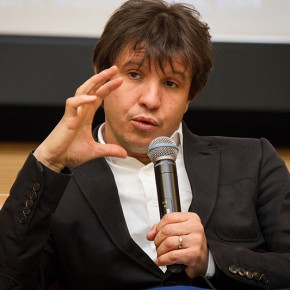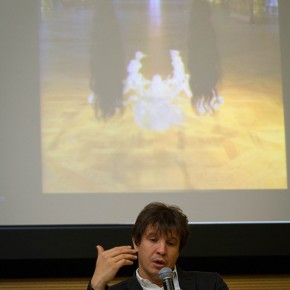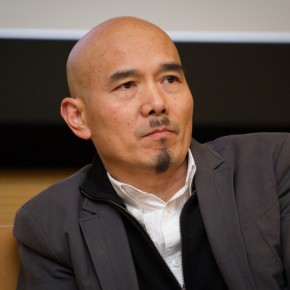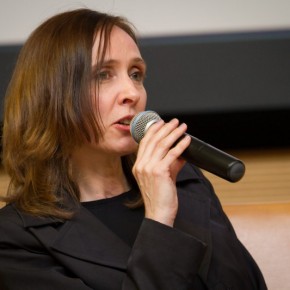
Group Photo of Yang Tianna, Adel, Wang Huangsheng, Sui Jianguo, and Yang Jiechang
Organized by CAFA Art Museum, a lecture entitled “The Attack + Give Me a Brush” was held in the Lecture Hall of CAFA Art Museum, at 18:30, on April 19, 2013. Presided over by Wang Huangsheng and Yang Tianna, the lecture was about the experiences and creations of Adel Abdessemed and Yang Jiechang.
At the beginning, Wang Huangsheng gave a brief introduction to the artists. Born in Algeria, Adel Abdessemed graduated from Lyon Academy of Fine Arts in France, working as an artist in France. Yang Jiecang graduated from the Guangzhou Academy of Fine Arts, and went to France. Yang Tianna said, Adel always focused on the participation, while the works of Yang Jiecang had a Chinese literati composition of ink, and she was the translator for Adel in the lecture.
Screening the pictures, Adel gave a brief overview of his works and art career. The first screening was a video projection “Flute Player”, where a naked man from the Islamic culture kept standing and playing his flute, and the role was selected from a large mass over a long period, realizing that he could continue his art creation with successful works. Since then, he has found himself to be more and more heading towards a realization of Freud’s “Daydream” with action, as well as his artistic “Daydream”. This “action” is not “performance”, which involves not only participation, but also some other methods.
Adel showed his own participating works, and spoke of several methods. Firstly, the dangerous performance works “Helicopter” and “The Sea”, secondly, the creations of animal remains, such as “Don’t Trust Me” and “Factory”, and “Who’s Afraid of the Big Bad Wolf”, a collage made with the heads of the animals, Adel stressed the traces of the animal, he believed, it brought a strong deterrent effect with the artistic expression. Thirdly, it is painting or sculpture, in “The Parade”, he directly used original fresco patterns, and “Coup de Tête”, a giant bronze sculpture depicting the infamous moment during the 2006 World Cup when French captain Zinédine Zidane head butted Italian defender Marco Materazzi in the chest, a symbol of freedom and the dark side of human nature, the symbolic photo involving a symbolic meaning.
Adel gave a detailed introduction of his works “Like Mother Like Son”, he believed that his art style was not separated from their memories. In his memory, as a housekeeper of the family, his mother cooked according to the economic situation, slowly like his mother, he used all the materials, he could find instead of deliberately seeking new items, on the other hand, he had been convinced that “regardless of winning or losing, one should start again”, which makes his works always fresh. Adel thought himself a “graphic artist" instead of a “conceptual artist”, he has been focused on the pursuit of the beauty of the visual art, various artistic forms he has made, he has been round the factors of “self act” and “visual”, which make him different from other contemporary artists.
After Adel’s speech, Yang Jiechang initially screened a video works “Oh My God”, as a native of Guangdong Province, he translates between Cantonese and English, writing words in the English alphabet of the two languages, Yang hoped that the conversion of languages and the power of language tone were emphasized through this works. He talked about the first creation that badly impressed him, the graduate works entitled “Massacre”, which shocked many people at that time as it opposed the domestic mainstream principle of “truth, kindness and beauty”, but for Yang Jiechang, it is the power to inspire that is his constant creation.
When he moved to France, he always insisted on using a brush for creation, he believed that the tradition of Chinese ink and wash is a glittering section of contemporary art. He was inspired by many years of training in Chinese calligraphy which enabled him to be explored by the curator of the exhibition “Les magiciens de la terre”, held at the Centre Georges Pompidou. He was noted for the “100 Layers of Ink”, directly interpreted as the use of “Sanfanjiuran”, a traditional technique for meticulous painting, deepening the color of the ink over time, to an ultimate effect as shiny as a mirror. He has also painted his nails and fingerprints using 100 layers of ink, a symbol of the awareness of life and the individual.
Yang Jiechang deals with all things he encounters in an artistic way. When he did not know how to deal with death, he created the “Testament”; when he lived in France, missing friends and family in China, he wrote their names, imagery of people standing in front of him. In addition, he had thoughts on the position of Guangdong culture as located in Chinese civilization. In the “We are Good at Everything Except for Speaking Mandarin”, a work full of banter, Yang was thinking about a legitimate rejected regional cultural, as well as his individual identity at home and abroad.
Finally it was the Q and A section, Adel and Yang answered some questions from the audience.
Journalist: Sun Tianyi/CAFA? ART INFO
Photography: Hu Zhiheng/CAFA ART INFO
Translated by Chen Peihua and edited by Sue/CAFA ART INFO





































